
A mask is an object normally worn on the face, typically for protection, disguise, performance, or entertainment, and often employed for rituals and rites. Masks have been used since antiquity for both ceremonial and practical purposes, as well as in the performing arts and for entertainment. They are usually worn on the face, although they may also be positioned for effect elsewhere on the wearer's body.

The Dogon are an ethnic group indigenous to the central plateau region of Mali, in West Africa, south of the Niger bend, near the city of Bandiagara, and in Burkina Faso. The population numbers between 400,000 and 800,000. They speak the Dogon languages, which are considered to constitute an independent branch of the Niger–Congo language family, meaning that they are not closely related to any other languages.
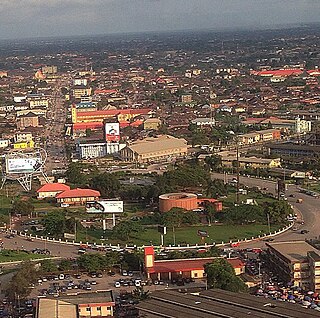
Benin City is the capital and largest city of Edo State, southern Nigeria. In central Kings square, the Benin city National Museum traces the Benin empire and has displays of terracotta sculpture. The Oba's palace is known for bronze plaques that once decorated with the walls, depicting historical events and Life at court. It is the fourth-largest city in Nigeria according to the 2006 census, after Lagos, Kano, and Ibadan. It is situated approximately 40 kilometres (25 mi) north of the Benin River and 320 kilometres (200 mi) by road east of Lagos. Benin City is the centre of Nigeria's rubber industry, and oil production is also a significant industry.
The Benin Expedition of 1897 was a punitive expedition by a British force of 1,200 men under Sir Harry Rawson in response to the ambush of a previous British embassy under Acting Consul General James Phillips, of the Niger Coast Protectorate. Rawson's troops captured and sacked Benin City, bringing to an end the Kingdom of Benin, which was eventually absorbed into colonial Nigeria.

African art describes the modern and historical paintings, sculptures, installations, and other visual culture from native or indigenous Africans and the African continent. The definition may also include the art of the African diasporas, such as: African-American, Caribbean or art in South American societies inspired by African traditions. Despite this diversity, there are unifying artistic themes present when considering the totality of the visual culture from the continent of Africa.
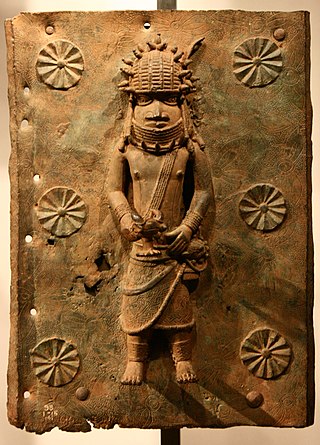
The Benin Bronzes are a group of several thousand metal plaques and sculptures that decorated the royal palace of the Kingdom of Benin, in what is now Edo State, Nigeria. Collectively, the objects form the best examples of Benin art and were created from the thirteenth century by artists of the Edo people. The plaques, which in the Edo language are called Ama, depict scenes or represent themes in the history of the kingdom. Apart from the plaques, other sculptures in brass or bronze include portrait heads, jewelry, and smaller pieces.
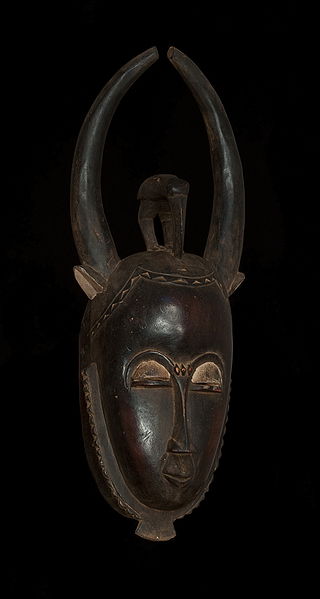
The Baule or Baoulé are a Akan people and one of the largest ethnicities in Côte d'Ivoire. The Baoulé are traditionally farmers who live in the centre of Côte d'Ivoire, in a French braid shaped region between the rivers Bandama and N'Zi. This area broadly encompasses the regions around the cities of Bouaké and Yamoussoukro. The Baoulé have come to play a relatively important role in the recent history of Côte d'Ivoire: the State's first President, Félix Houphouët-Boigny, was a Baoulé; additionally, since the Ivorian cocoa boom of the 1960-1970s, the Baoulé have also become one of the most widespread ethnicities throughout the country, especially in the Southern forests where they are amongst the most numerous planters of cocoa, rubber, and coffee and sometimes seem to outnumber the local native ethnic groups.
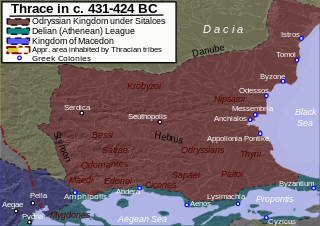
The Thracians were a group of Indo-European tribes inhabiting a large area in Central and Southeastern Europe, centred in modern Bulgaria. They were bordered by the Scythians to the north, the Celts and the Illyrians to the west, the Greeks to the south, and the Black Sea to the east.
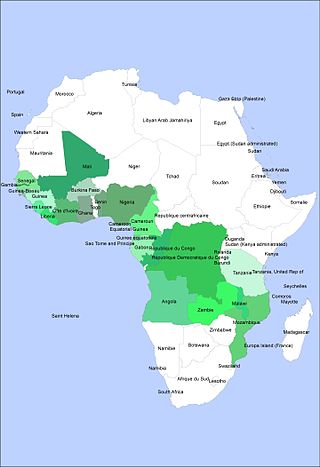
Traditional African masks play an important role in ceremonies, rituals, and masquerades across West, Central, and Southern Africa. Ceremonies in which masks are worn include harvest celebrations, funerals, rites of passage, weddings, and coronations. In some societies, masks and masquerades are also used to settle disputes and communal conflicts.

Most African sculpture was historically in wood and other organic materials that have not survived from earlier than at most a few centuries ago; older pottery figures are found from a number of areas. Masks are important elements in the art of many peoples, along with human figures, often highly stylized. There is a vast variety of styles, often varying within the same context of origin depending on the use of the object, but wide regional trends are apparent; sculpture is most common among "groups of settled cultivators in the areas drained by the Niger and Congo rivers" in West Africa. Direct images of African deities are relatively infrequent, but masks in particular are or were often made for traditional African religious ceremonies; today many are made for tourists as "airport art". African masks were an influence on European Modernist art, which was inspired by their lack of concern for naturalistic depiction.

Idia was the mother of Esigie, who reigned as Oba (king) of the Edo people from 1504 to 1550. Historians do know that Idia was alive during the Idah war because she played a role that led to a great Benin victory. It has been argued that Idia, therefore, was the true power behind the throne of her son. She played a significant role in the rise and reign of her son, being described as a great warrior who fought relentlessly before and during her son's reign as the Oba (king) of the Edo people. Queen Idia was instrumental in securing the title of Oba for her son Esigie following the death of his father Oba Ozolua. To that end, she raised an army to fight off his brother Arhuaran who was supposed to be the Oba by right and tradition but was subsequently defeated in battle. Esigie’s mother became the 17th Oba of Benin.

A masquerade ceremony is a cultural or religious event involving the wearing of masks. The practice has been seen throughout history from the prehistoric era to present day. They have a variety of themes. Their meanings can range from anything including life, death, and fertility. In the Dogon religion, the traditional beliefs of the Dogon people of Mali, there are several mask dances, including the Sigi festival. The Sigi entered the Guinness Book of Records as the "Longest religious ceremony".
The Miracle of Bali is a BBC series of cultural documentaries narrated by David Attenborough and first shown in 1969. The series comprises three programs about the culture of Bali. The complete series is available as a special feature on the DVD release of David Attenborough's 1975 series The Tribal Eye.

The Yoruba of West Africa are responsible for a distinct artistic tradition in Africa, a tradition that remains vital and influential today.

The visual arts of the Indigenous peoples of the Americas encompasses the visual artistic practices of the Indigenous peoples of the Americas from ancient times to the present. These include works from South America and North America, which includes Central America and Greenland. The Siberian Yupiit, who have great cultural overlap with Native Alaskan Yupiit, are also included.
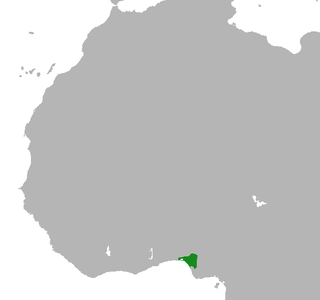
The Kingdom of Benin, also known as the Edo Kingdom or the Benin Empire, was a kingdom within what is now southern Nigeria. It has no historical relation to the modern republic of Benin, which was known as Dahomey from the 17th century until 1975. The Kingdom of Benin's capital was Edo, now known as Benin City in Edo State, Nigeria. The Benin Kingdom was "one of the oldest and most developed states in the coastal hinterland of West Africa". It grew out of the previous Edo Kingdom of Igodomigodo around the 11th century AD, and lasted until it was annexed by the British Empire in 1897.
The Hemba people are a Bantu ethnic group in the Democratic Republic of the Congo (DRC).
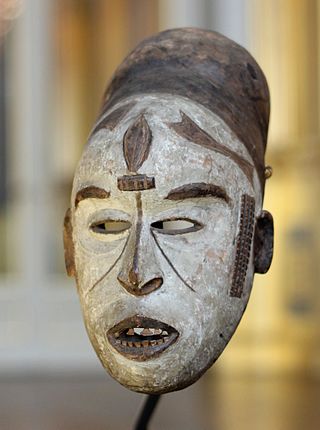
Some African objects had been collected by Europeans for centuries, and there had been industries producing some types, especially carvings in ivory, for European markets in some coastal regions. Between 1890 and 1918 the volume of objects greatly increased as Western colonial expansion in Africa led to the removal of many pieces of sub-Saharan African art that were subsequently brought to Europe and displayed. These objects entered the collections of natural history museums, art museums and private collections in Europe and the United States. About 90% of Africa's cultural heritage is believed to be located in Europe, according to French art historians.

Awa, also known as the Awa Society, the Society of Masks, is an African mask and initiatory society of the Dogon people of Mali which is made up of circumcised men, and whose role is both ritual and political within Dogon society. The Awa Society takes an important role in Dogon religious affairs, and regularly preside over funereally rites and the dama ceremony—a ritual ceremony that marks the end of bereavement in Dogon country. This Society is one of the important aspect of Dogon religious life—which is primarily based on the worship of the single omnipotent, omniscient and omnipresent Creator God Amma and the veneration of the ancestors. Although it is only one aspect of Dogon's religious sects, it is perhaps more well known than the others partly due to Dogon mask–dance culture which attracts huge tourism, and their masks highly sought after, and in fact, one of the first to be sought after by art collectors in the west.

The Ibadan National Museum of Unity is an ethnographic museum in Ibadan, Nigeria. The museum is dedicated to the culture of the different ethnic groups of Nigeria.
















